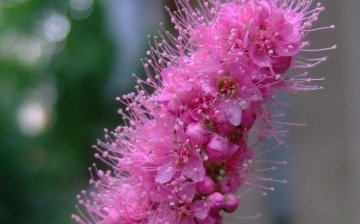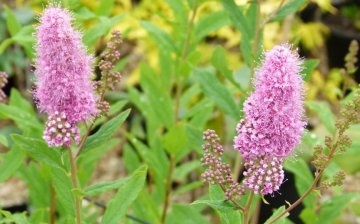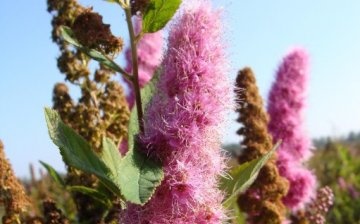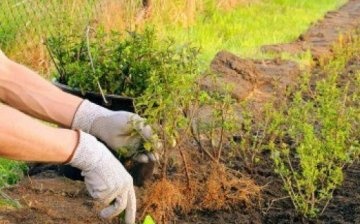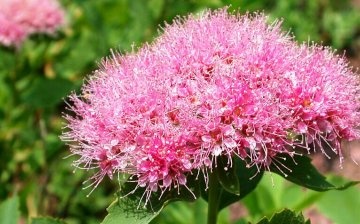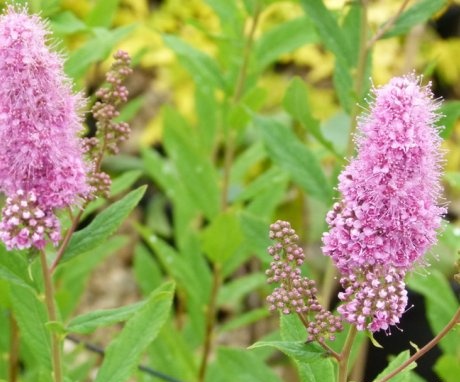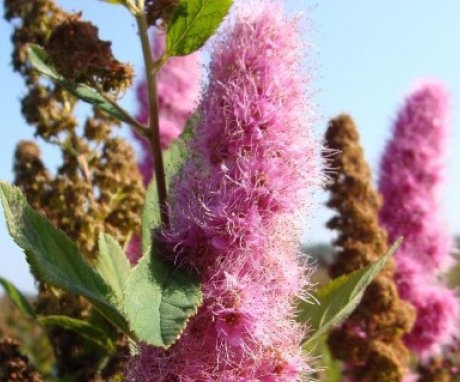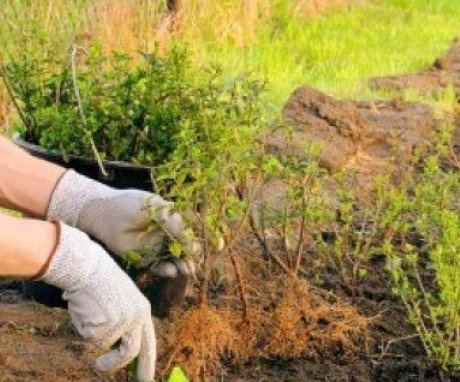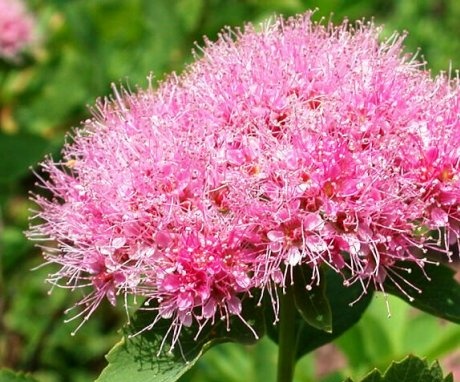Rules for reproduction, care and cultivation of Billard's spirea.
When choosing plants for landscaping areas, designers give preference to decorative, but at the same time unpretentious plants in care. If you look for such among the bushes, then Billard's spirea is ideal in all respects.
Content
- Spirea Billard: distinctive features
- Billard's spirea planting rules
- How to care for a culture?
- Reproduction methods
- Other popular varieties of spirea
- Application in landscape design
Spirea Billard: distinctive features
The plant belongs to the genus Spirea from the Rosaceae family. This is decorative deciduous shrubsespecially beautiful during flowering. The name of the genus is translated from Greek as "bend". The plants were christened that way for the gracefully curved branches of most varieties of spirits.
The genus includes about 100 species of wild and cultivated shrubs. They differ from each other by the flowering period, the appearance of the bush. Foliage and inflorescences are also of different shades and shapes. This species abundance is explained by the fact that spireas give persistent hybrids.
All shrubs are divided into 3 main groups:
- Early flowering
- Summer
- Late.
The former decorate the garden from May to June, the latter at the end of summer. Plants from the latter group form inflorescences when they meet autumn. Billard's spirea belongs to the summer-flowering species. The bush is the result of crossing the Douglas spirea and willow spirea. Since 1854 in culture.
The plant is large, conquers a height of 2 m. It is not afraid of the cold.
The bushes are perfectly grown from Arkhangelsk to the Caucasus, in Central Asia. On the spreading straight branches, interesting leaves attract attention: broadly lanceolate, 10 cm long, grayish-tomentose on the underside. With the arrival of autumn, their color changes to brownish red.
Bright pink pyramidal or paniculate inflorescences are rather long (up to 20 cm). They crown the top of each shoot. They consist of many flowers, somewhat reminiscent of small cherries. The shrub throws them out, starting in the second half of summer, and continues to do so until the first frost. Billard's Spirea is a spectacular late shrub that is prized for its long flowering.
Billard's spirea planting rules
The ideal place for a flowering plant is a sunny area. If there is no such area, the culture will grow successfully in partial shade.
Spireas love rich soils.
They will actively develop, forming new shoots. On depleted soil, the shrub will not look the same, but it will not die. The condition of "bad" soil is easy to improve. It is prepared for planting a shrub using a mixture of turf (2 parts), sand and peat (1 part each). Instead of the first component, you can take sheet land.
Since this type of spirea belongs to summer flowering, it is successfully planted in the spring (until the leaves have blossomed) and in the fall (after the foliage has fallen off). If you miss the right moment, the plant will start to hurt and may die.
For garden work, choose a rainy or cloudy day.
Before planting seedlings, they are carefully examined. Too long shoots, broken or improperly growing stems are removed from an open rhizome.
Store seedlings are sold in containers.An hour before starting work, they are well watered. Before planting, they are removed from the container. They act very carefully, trying to leave an earthen lump intact.
Steps when planting Billard's spirea:
- Prepare pits: length and width of 40 cm, depth - 30 cm. Their volume should exceed the volume of the underground part of the plant by 25-30%.
- Set the spirea so that the root collar and the ground are at the same level.
- Spread the roots well.
- Cover with soil, combined with fertilizers (mineral fertilizing and rotted compost).
- Water abundantly.
- At first, the bushes will need drainage. It is made from sand and crushed bricks.
- If you use Billard as a hedge, then a distance of 40-50 cm is maintained between the bushes.The distance between the rows is 30-40 cm.In group planting, the bushes are planted every 50-70 cm.
A well-chosen time and place for planting Billard's spirea is a guarantee of her health and active development.
How to care for a culture?
The colorful shrub is surprisingly unpretentious. Its features:
- Winter hardiness.
- Durability.
- Withstands heat.
- It can do without watering for quite a long time.
- Insensitive to urban air pollution.
- Immune to pathogens.
- Almost not damaged by parasites.
- Thanks to these properties, Billard's spirea care is minimal. These are standard procedures - moderate watering, feeding, loosening.
- In drought conditions, it is important to moisturize the soil after flowering and pruning. After heavy rains, the soil is taken with a crust, which can provoke oxygen starvation of young bushes. To prevent this from happening, the soil will have to be loosened.
- Spirea roots are located close to the surface. It is recommended to mulch the area near the stem in the fall. This is done with any available material - compost, peat, walnut husks.
- Mulch is used only for planted bushes. The soil is covered with a layer of peat 7 cm high.
- In early spring, they devote time to top dressing. Introduce universal kemira (per 1 m2 - 110-125 g).
- Pruning is an important agricultural technique to rejuvenate the bush. Until the plant is 4 years old, it is not touched. This is the time for growth and active development. Spirea becomes strong, the root system grows.
- The six-year-old bush is no longer the same: it loses its shape and attractiveness. It means it's time for pruning.
Gardening work begins in the spring. Remove four-year and older shoots, leaving 20-30 cm from the ground. If you do not adhere to this recommendation, the old stems will move away from the center and lie on the soil. Cutting off some of the tops will result in too many young growths with unattractive flowers.
An overgrown bush may fall apart. Such a "pink fountain" will have to organize support in the form of a metal rod or a plastic tube bent into a ring.
Spirea allows you to decorate the site with a minimum of effort.
Reproduction methods
New plants are obtained from cuttings and cuttings. The seeds of Billard's hybrid spirea give heterogeneous shoots, so they are not used for planting. Cultivation in a vegetative way allows you to keep all the properties of the mother species unchanged.
Cutting:
- Raw materials are cut from the middle or top of semi-lignified stems of the current year.
- The length of the handle is 10 cm.
- You can help him form a rhizome by treating the tip with Kornevin solution before planting.
- With such a "doping", good roots will appear in 2 months. Only after 2-3 years will the spireas be ready for planting for permanent residence.
Layers:
- The method is used in the spring, for few plantings.
- Several branches, on which leaves began to bloom, bend to the ground and fit into previously prepared grooves.
- They need to be fixed with something (wire, stone) and covered with earth.
- Another option is also possible - the shoots are tied to pegs, directing them vertically upward.
To succeed, the soil must not be allowed to dry out. In conditions of constant humidity, independent plants are formed from the cuttings in autumn.
New bushes will benefit from picking the first inflorescences. Such actions are a way to activate the rapid growth of spirea. For the winter, shoots are hidden under dry leaves.
Billard's spirea cannot be propagated by seeds, but it is quite easy to do it vegetatively.
Other popular varieties of spirea
Shrubs of different species are so different from each other that sometimes the question arises: are these plants from the same genus? But all spirits have something in common - a colorful look, fragrant pollen, so beloved by bees.
The plants are so good honey plants that they are often planted near apiaries.
Sometimes spireas are called "meadows". From a biological point of view, this is wrong. Meadowsweet (meadowsweet) is a grass, and spirea is a shrub.
Popular representatives of the genus:
- Japanese spirea. Height - 1-1.5 m. Shoots have an edge, which disappears over time. The stems become glossy and reddish brown. The color of the oblong-oval leaves varies from brown with a reddish tint to rich green. Moreover, the color below is lighter. In autumn, the foliage takes on a rich yellow-orange or burgundy hue. At the end of the shoots there are pink inflorescences with a slightly convex middle.
- Spirea Douglas. A picturesque upright shrub 1.5 m high. The stems are pubescent, reddish-brown in color. The oblong-lanceolate foliage grows up to 10 cm. Flowers of a rich dark pink color form dense pyramidal inflorescences.
- Spirey Bumald. A hybrid of Japanese spirea and white-flowered spirea. A short bush (75 cm) with a graceful spherical crown and erect branches. Slightly ribbed shoots are glabrous. Long leaves (about 8 cm) are oval in shape. Pale pink flowers adorn the bush almost all summer.
- Spirea Wangutta. The result of crossing the spiraea Cantonese and three-lobed. Height - 2 m. The crown is a colorful cascade of spreading, downward-curving branches. The edge of the leaves (3 cm) is decorated with denticles. The foliage is dark green above and light gray below. The entire shoot is densely covered with virgin white inflorescences, similar to balls.
The world of spirits is so diverse that every gardener will definitely find his favorite plant in it.
Application in landscape design
Different types of shrubs emit inflorescences at different times. This is a unique opportunity to decorate the garden exclusively with representatives of the spire family. By choosing the right varieties, designers create continuously fragrant areas. From spring to autumn, the owners will be able to observe how the white spring color of the bushes will change to pink and crimson.
- Bushes differing in shape and size are used in plantings of different types. A lonely majestic queen will look like a sharp-toothed spirea, Wangutta, Douglas. Their arch-like shoots give the bush a beautiful shape.
- Almost all types of crops are suitable for group plantings. The composition will consist of several bushes of the same variety, planted side by side.
- Low-growing plants are planted around trees and taller shrubs... Ordinary green spaces can be framed with spireas with reddish or golden leaves.
- Borders stand out as small shrubs, and rockeries are made of them. They will decorate any alpine slide. Dwarf varieties are used as ground cover plants. Hedges are grown from white spirea, Douglas, Billard, willow.
- The composition of the bush and lilac... Down below - lilies of the valley, primroses, astilbe.
- The soil under the spireas can be hidden under a carpet of climbing perennials. Dark green periwinkle, variegated and multicolored lungwort, gray cerastium, lamb, yellow zelenchuk will do.
- Flowering shrubs and bulbs are the perfect ensemble. The main messengers of spring - tulips, daffodils, crocuses, hazel grouses - will complement the harmony of the garden.
Skillfully selecting and combining different types of spirits, designers create areas that bloom continuously from spring to late autumn. Spirea Billard is a bright shrub that is quite capable of becoming the "pearl" of the garden. Its undoubted advantage is its undemandingness to the conditions of detention.
More information can be found in the video.



